











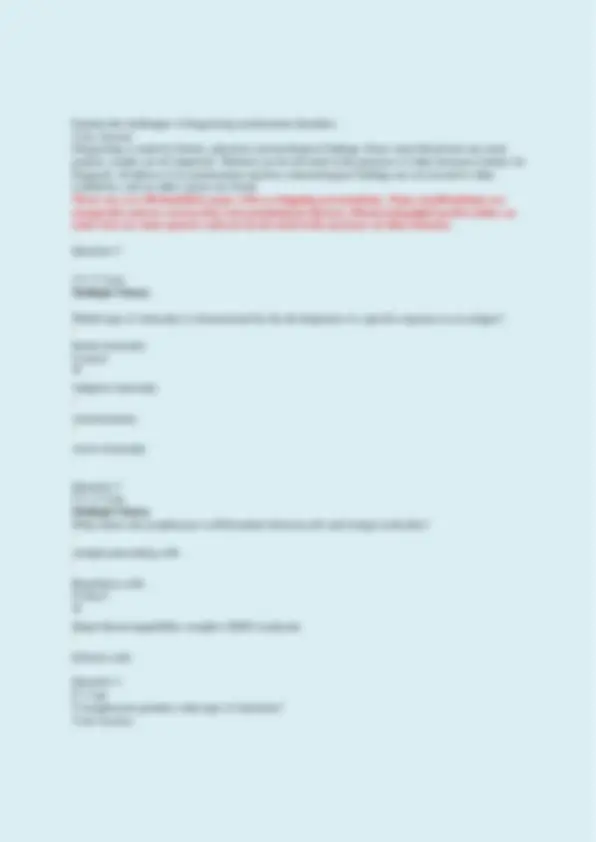









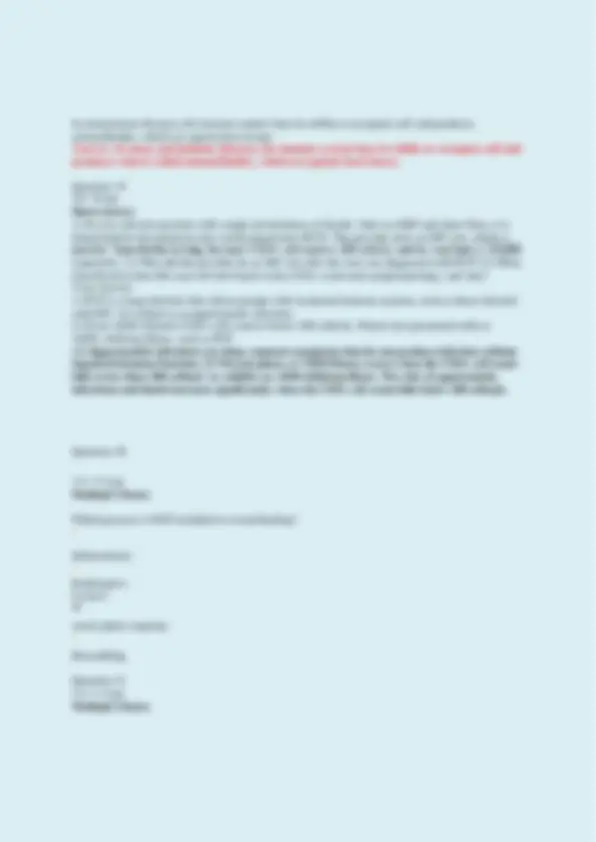






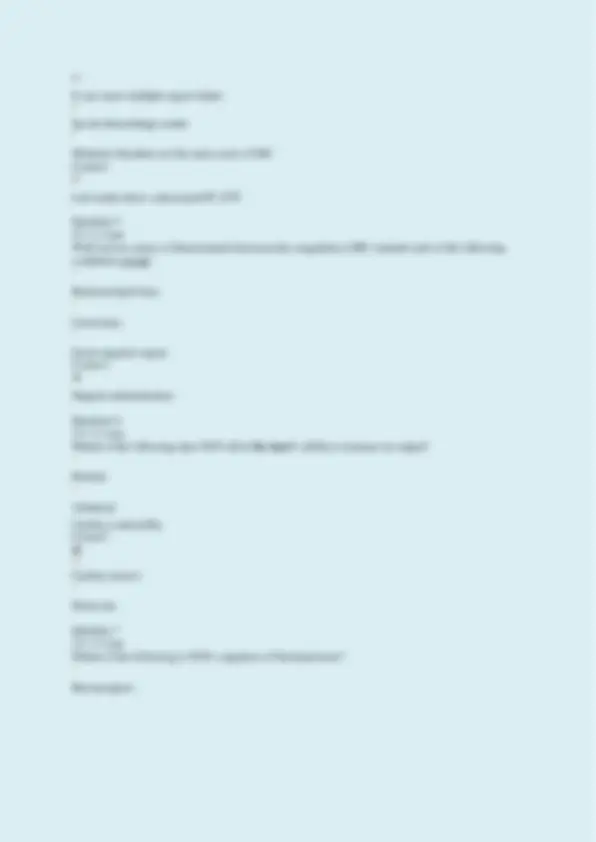





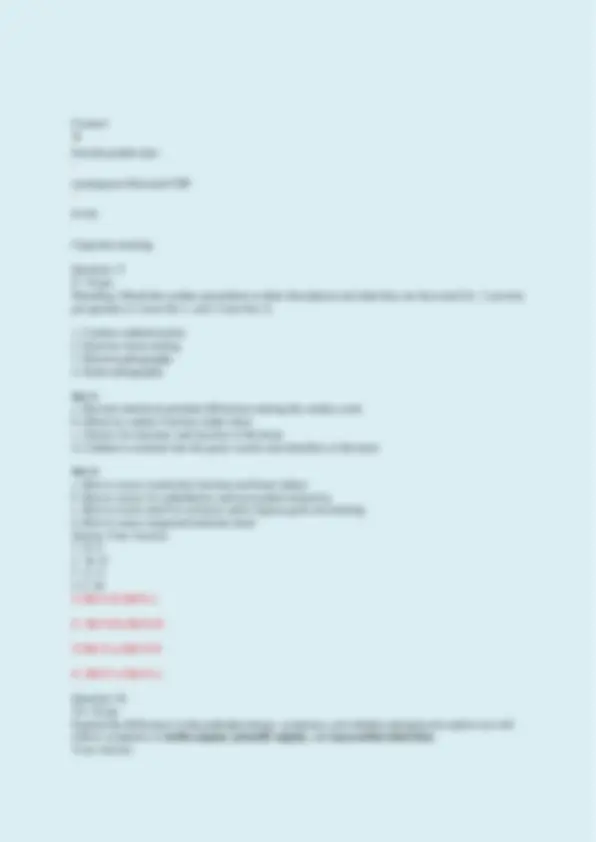
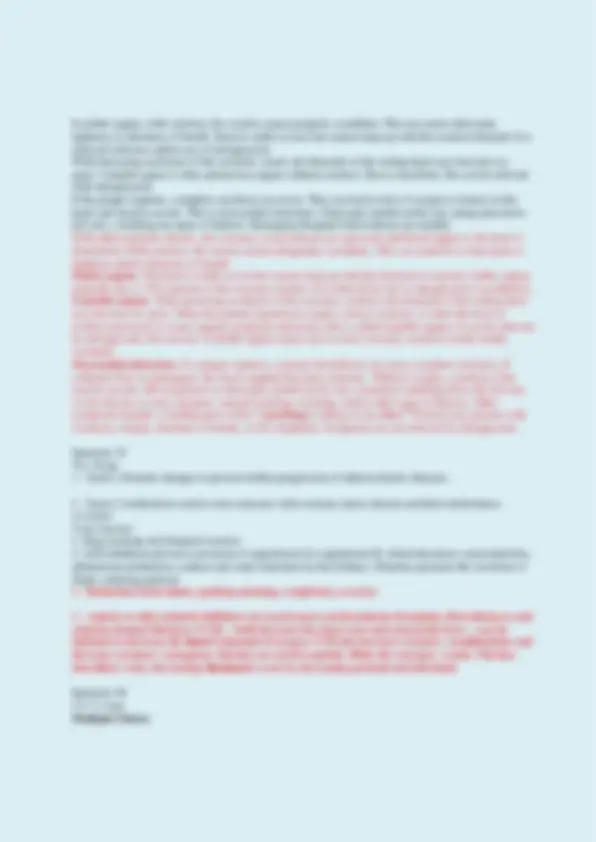




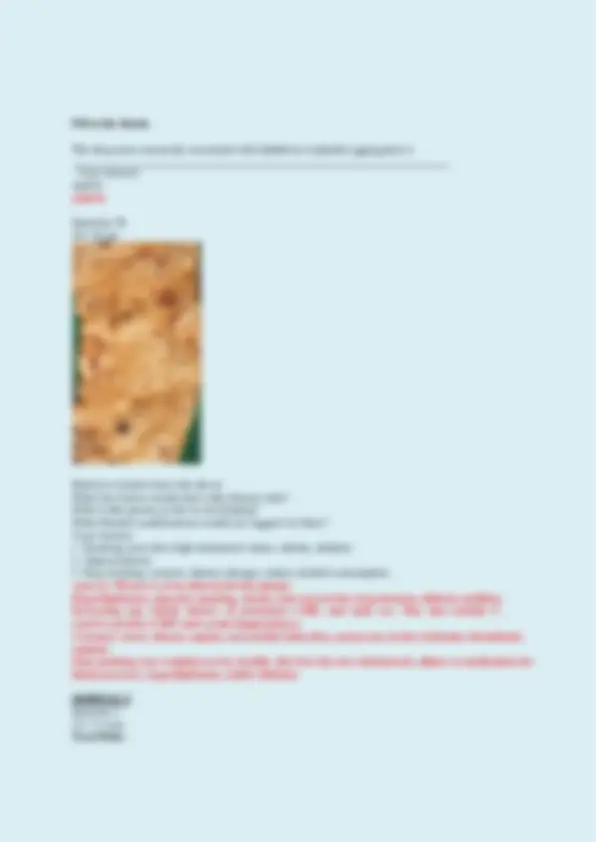





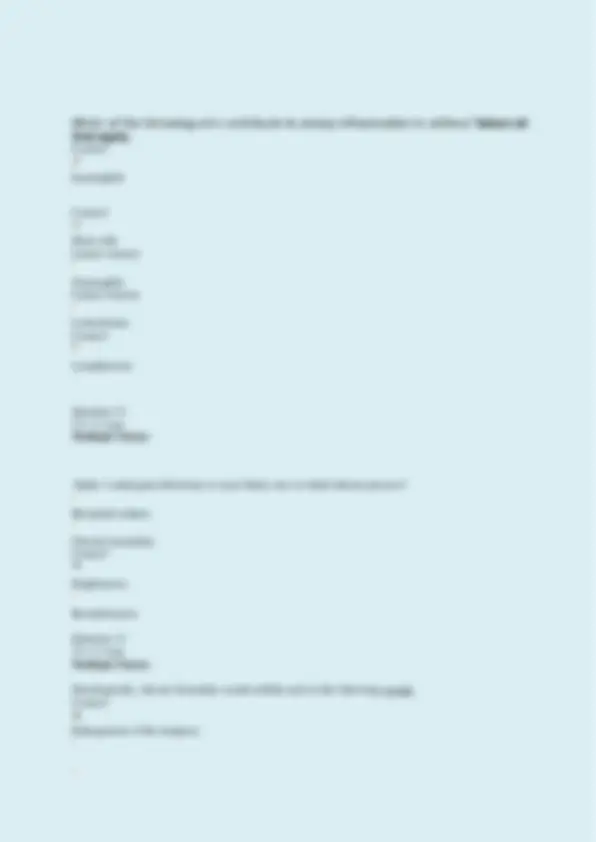

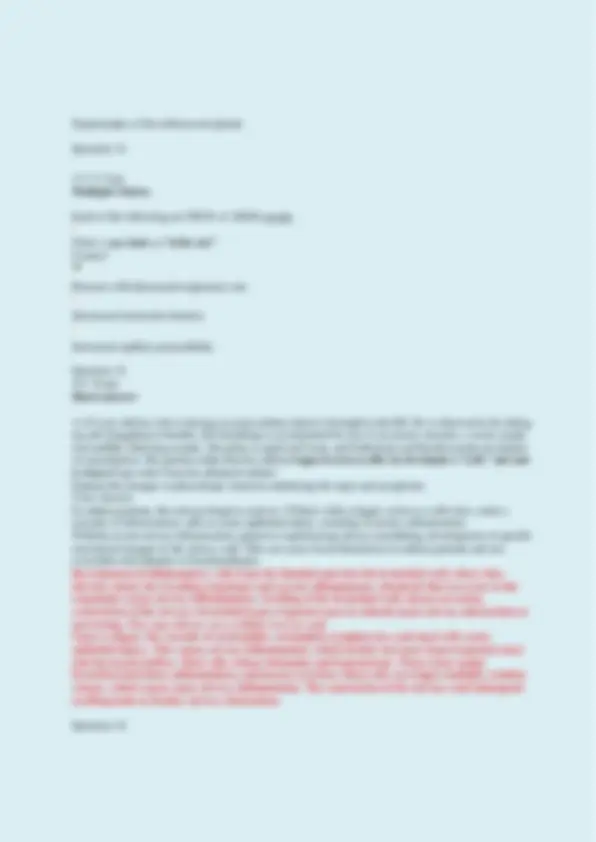

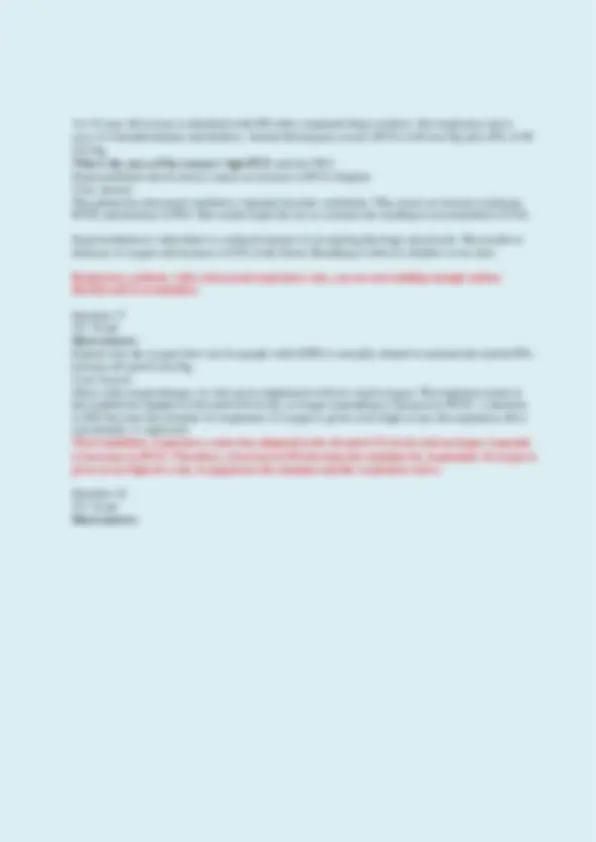
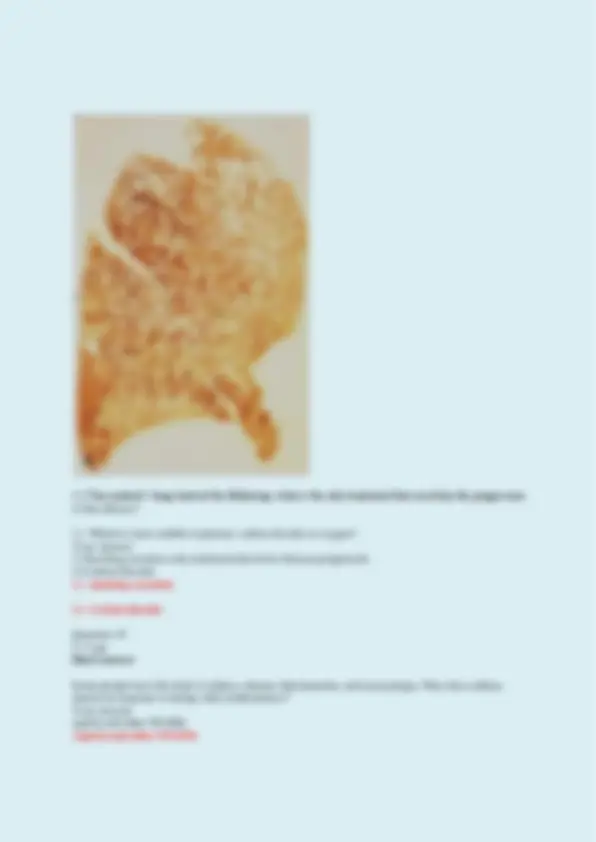



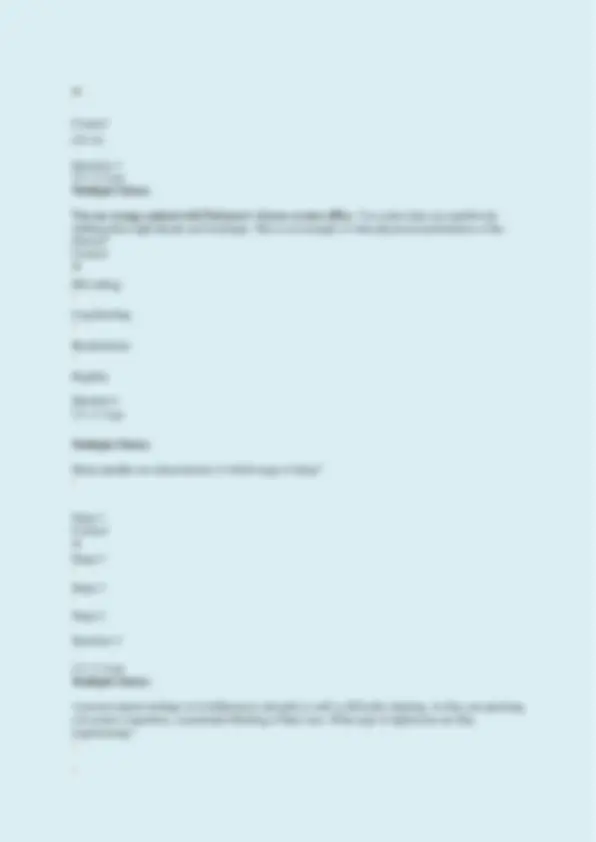

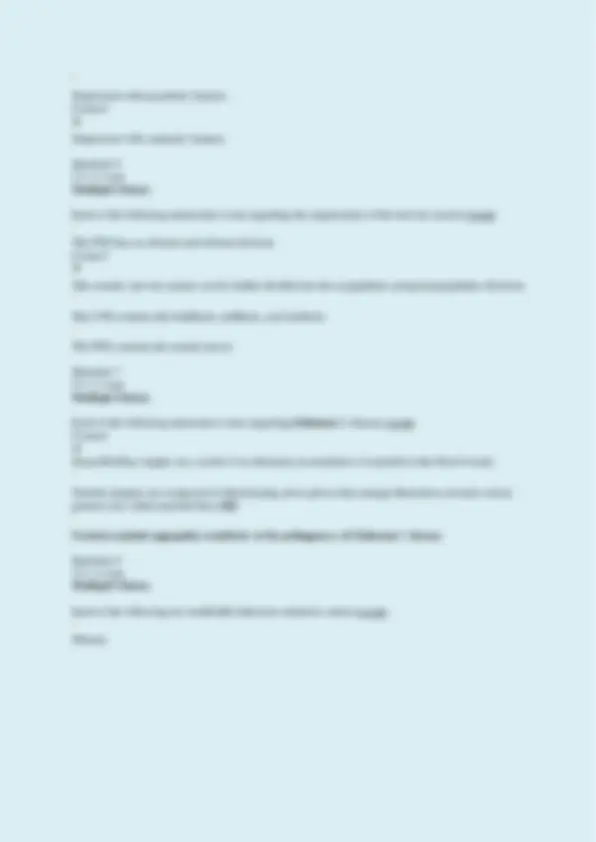


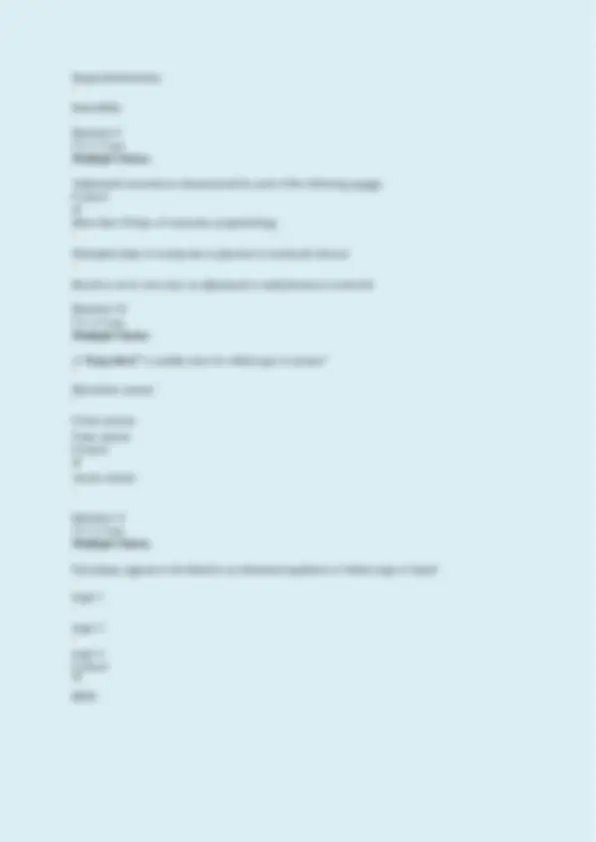

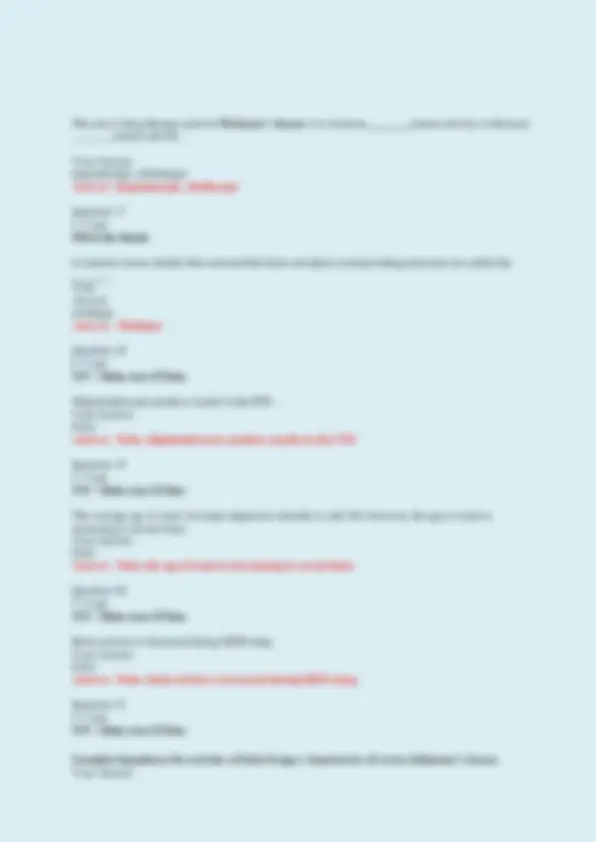
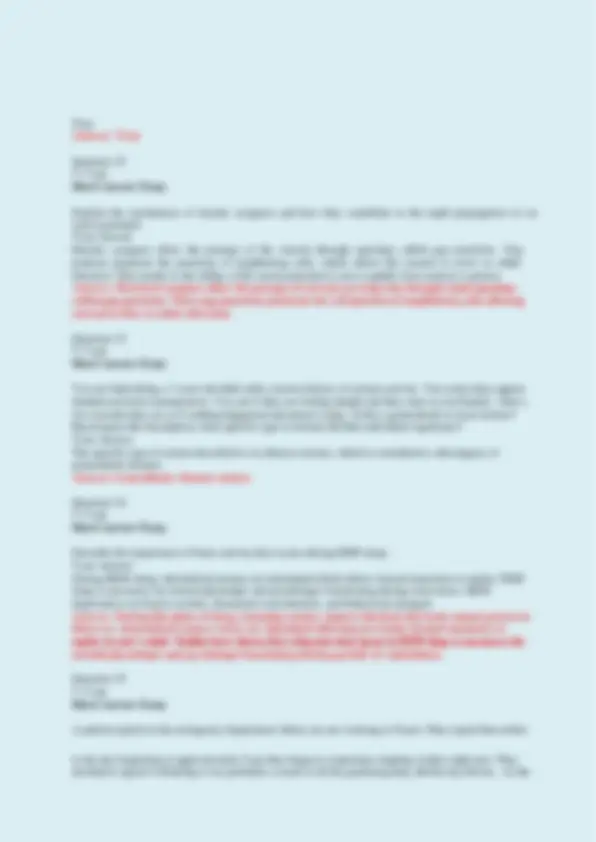
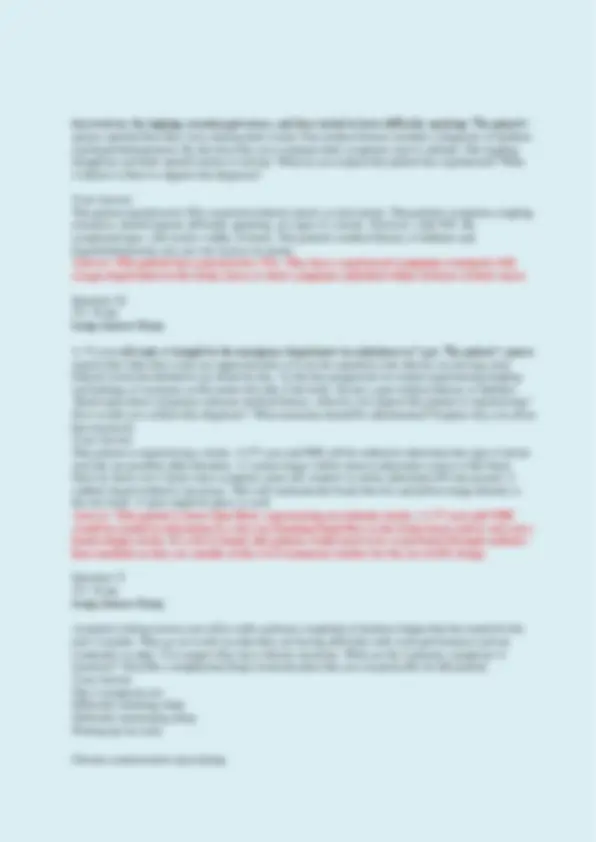








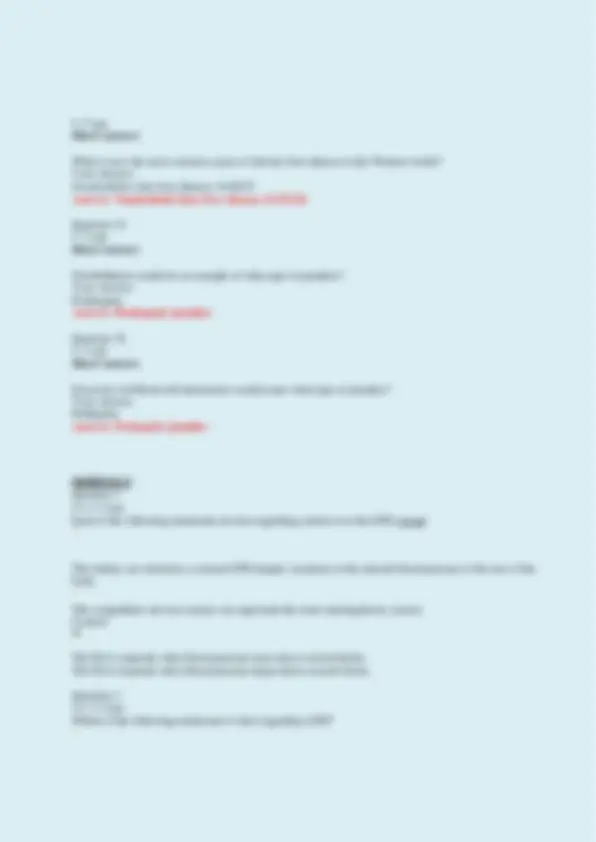

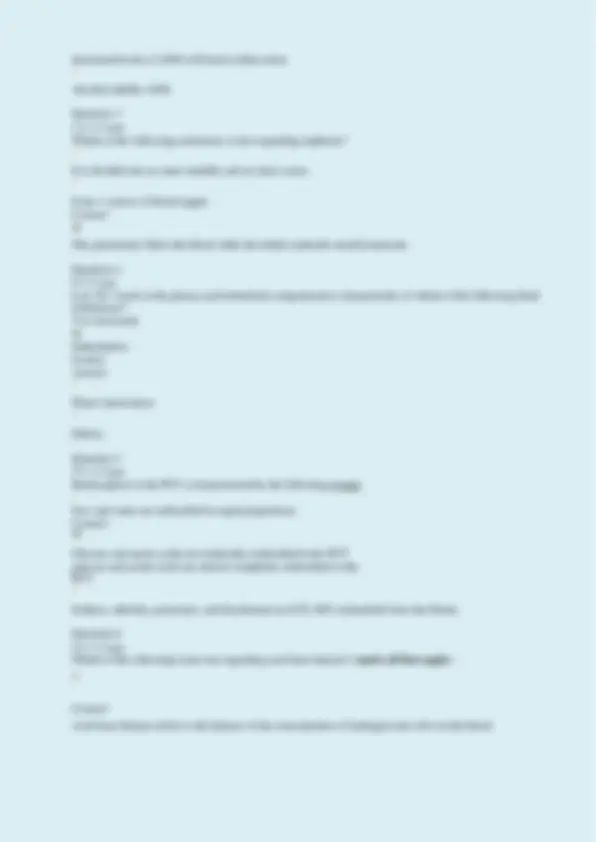
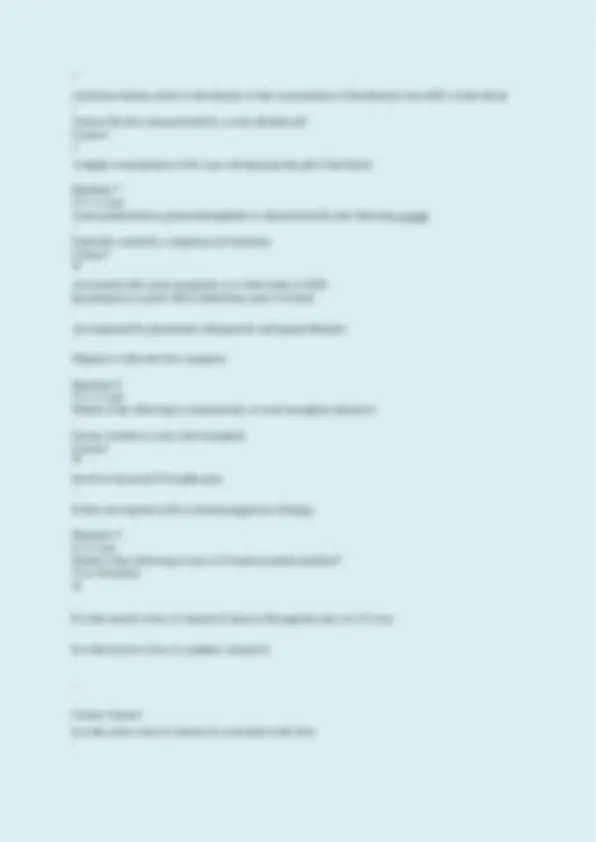

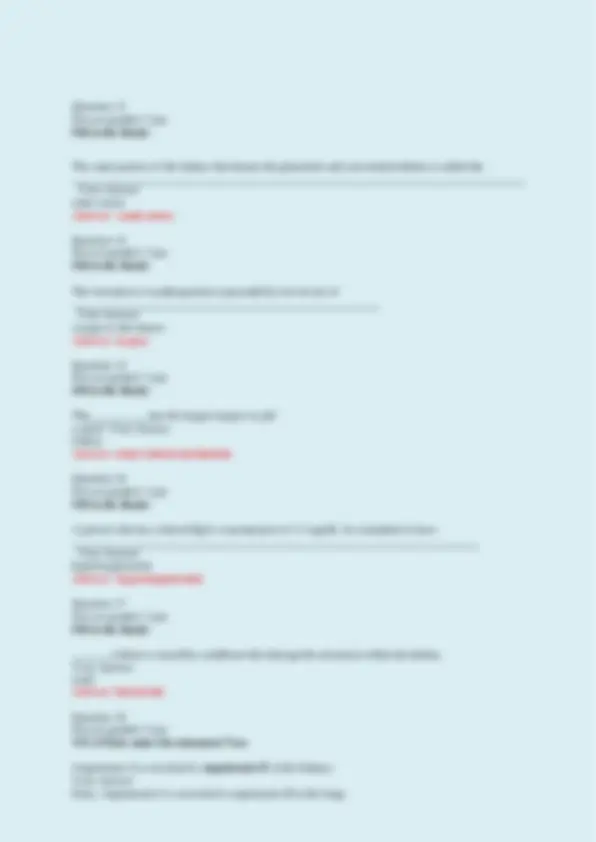

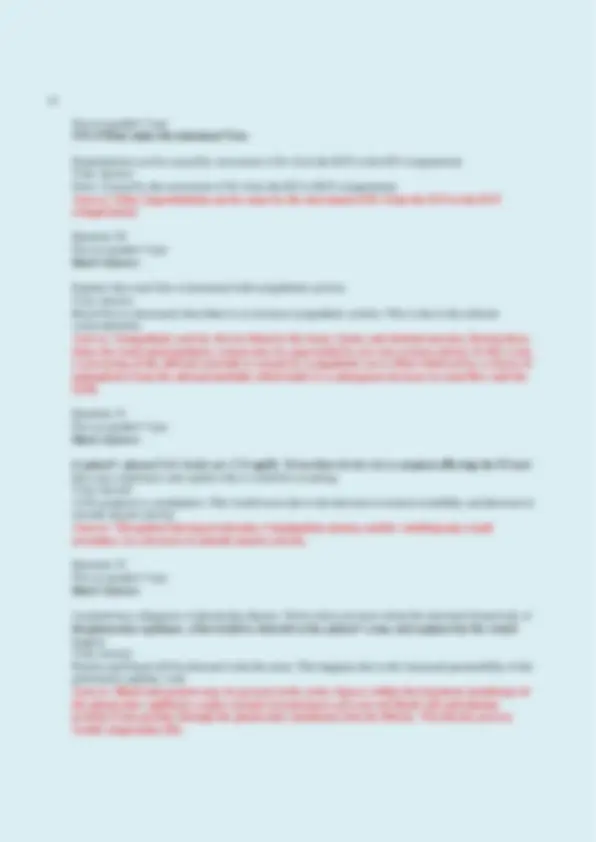
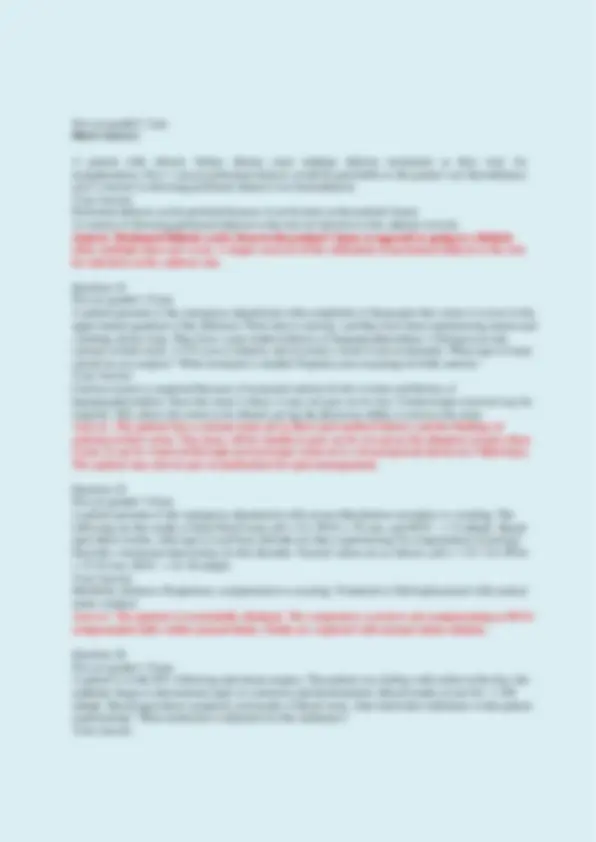


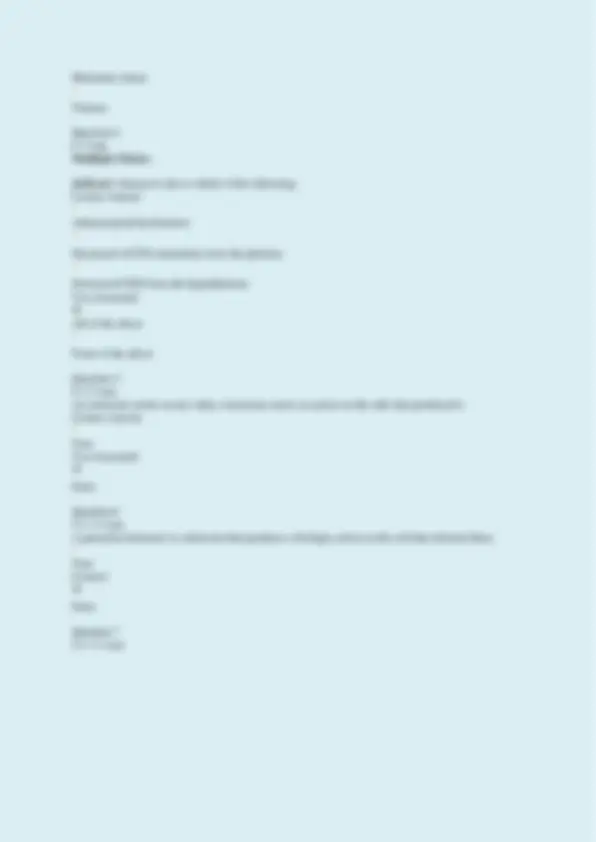



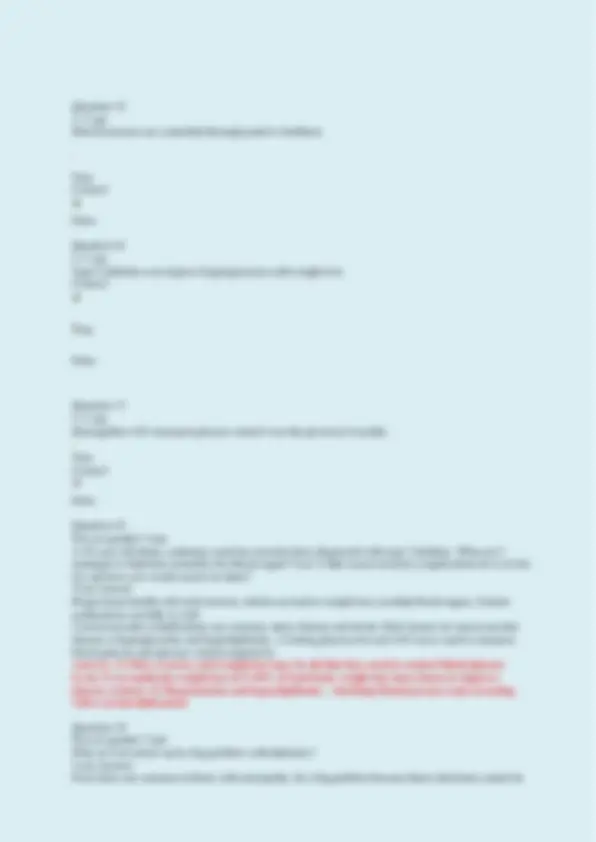

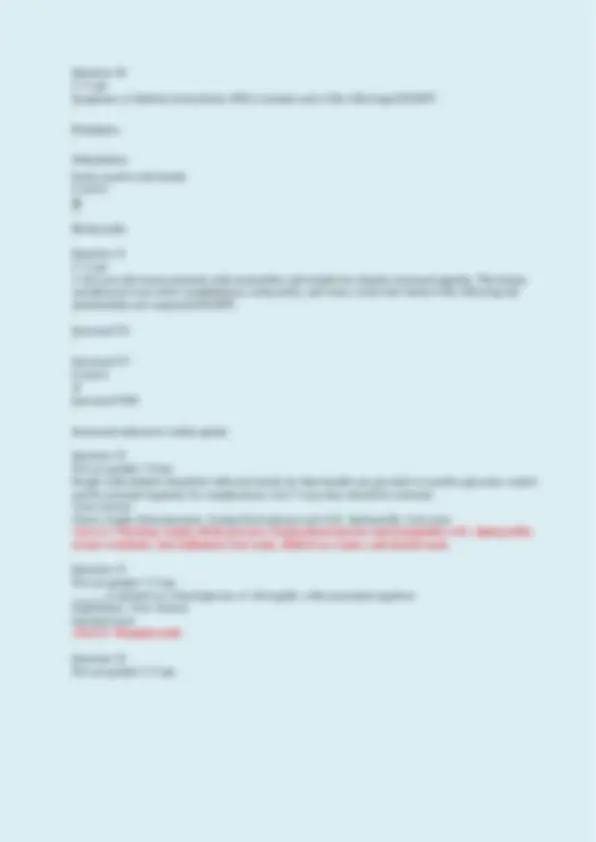
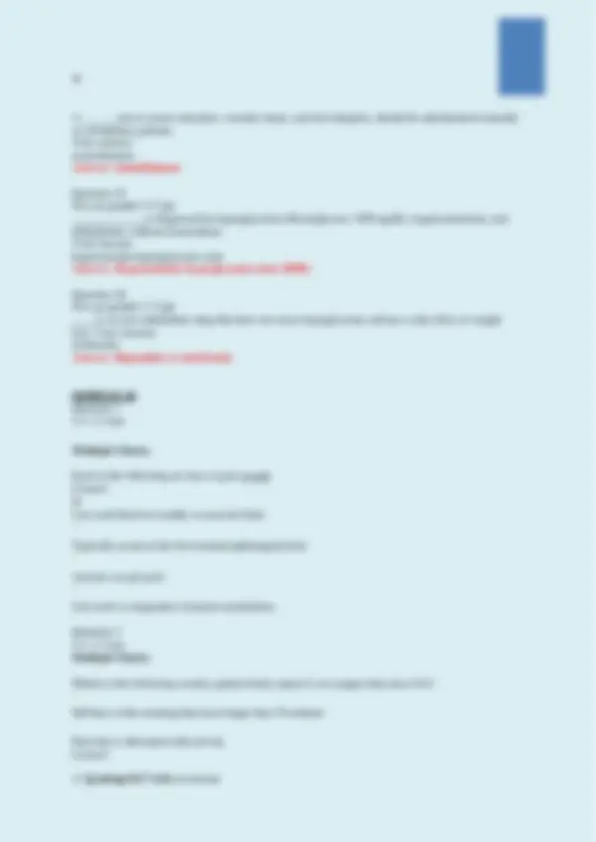


Study with the several resources on Docsity

Earn points by helping other students or get them with a premium plan


Prepare for your exams
Study with the several resources on Docsity

Earn points to download
Earn points by helping other students or get them with a premium plan
Community
Ask the community for help and clear up your study doubts
Discover the best universities in your country according to Docsity users
Free resources
Download our free guides on studying techniques, anxiety management strategies, and thesis advice from Docsity tutors
NURS 231 MODULE 1- 10 EXAM PATHOPHYSIOLOGY PORTAGE LEARNING QUESTIONS & CORRECT ANSWERS
Typology: Exams
1 / 108

This page cannot be seen from the preview
Don't miss anything!





























































































Module 1 Exam Question 1 2.5 / 2.5 pts True/False: A bodybuilder’s muscles will display hyperplasia. True Correct! False It will display hypertrophy. Question 2 2.5 / 2.5 pts True/False: Barrett esophagus is an example of dysplasia. True Correct! False It’s metaplasia. Question 3 0 / 2.5 pts True/False: Hypertrophy is an increase in the size of an organ or tissue caused by an increase in the number of cells You Answered True Correct Answer False Question 4 2.5 / 2.5 pts True/False: Hypertrophy can occur under normal and pathological conditions. Correct! True
False Question 5 10 / 10 pts Match the following: Deals with the cause of death in a population a. Incidence Number of new cases in a population at risk during a specified time b. Prevalence Number of people with the disease in a population in a given time c. Morbidity The effect of an illness on one’s life d. Mortality Question 6 2.5 / 2.5 pts Multiple Choice Which is NOT true of the cytoskeleton? It controls shape and movement Cilia and flagella are microtubule-filled cellular extensions Correct! It includes peroxisomes and proteasomes Peroxisomes and proteasomes are not part of the cytoskeleton.
Pathophysiology Physiology You Answered No answer text provided. Question 11 2.5 / 2.5 pts Multiple Choice A patient has a fever and rash. What are these examples of? Correct! Signs Symptoms Both A & B Question 12 2.5 / 2.5 pts Multiple Choice Which of the following is true of a test’s sensitivity? It is how likely the same result will occur if repeated Correct! If negative, it can safely be assumed that the person does not have a disease It is considered a true-negative result It can only be calculated from people without the disease Question 13 2.5 / 2.5 pts Multiple Choice Which of the following is the effect of an illness on one’s life? Incidence Correct! Morbidity
Prevalence Mortality Question 14 10 / 10 pts Define secondary prevention and give an example: Your Answer: It is one of three categories in disease prevention. It aims to detect and treat disease early, while the disease is asymptomatic and curable. An example is an annual Pap smear. Secondary prevention aims to detect and treat disease early, usually while the disease is asymptomatic and curable. Some examples include annual Pap smears to detect early cervical cancer, encouraging smoking cessation, checking blood pressure and cholesterol, and colonoscopy screening. Question 15 10 / 10 pts Compare and contrast the two types of gangrenous necrosis. Your Answer: 2 types are dry and moist. In dry gangrenous, the affected tissue is dehydrated, shrinks back and becomes dark brown or black in color. THe spread of dry is slow. In wet, the affected area is cold, swollen, with no pulse. The skin is moist, black, and distended. Small blisters form and as liquefaction occurs, foul ordor emerges. The spread of wet gangrenous is rapid. In dry gangrene the affected tissue becomes dry and shrinks, the skin wrinkles, and its color changes to dark brown or black. The spread of dry gangrene is slow. It results from a cut off in arterial blood supply and is a form of coagulation necrosis. In wet gangrene, the affected area is cold, swollen, and pulseless. The skin is moist, black, and under tension. Blebs form on the surface, liquefaction occurs, and a foul odor is caused by bacterial action. The spread of tissue damage is rapid. Question 16 10 / 10 pts Explain what necrosis is and give an example and description of one type of necrosis. Your Answer: Necrosis is cell death in tissue or organ that is still part of a living person. An example of a type of necrosis is coagulative necrosis. This results from a sudden cutoff of the blood supply to an organ, such as the heart. Necrosis refers to cell death in an organ or tissues that is still part of a living person. It often interferes with cell replacement and tissue regeneration. Coagulative necrosis results most often from a sudden cutoff of blood supply to an organ (ischemia), particularly the heart and kidney. Liquefactive necrosis occurs when some of the cells die but their catalytic enzymes are not destroyed. It is commonly seen with brain infarcts or abscesses. Caseous necrosis occurs as part of granulomatous inflammation and is most often associated with tuberculosis. Gangrenous necrosis most often affects the lower extremities or bowel and is secondary to vascular occlusion. The term gangrene is applied when a considerable mass of tissue undergoes necrosis. In dry gangrene the affected tissue becomes dry and shrinks, the skin wrinkles, and its color changes to dark brown or black. The spread of dry gangrene is slow. It results from a cut off in arterial blood supply and is a form of coagulation necrosis. In wet gangrene, the affected area is cold, swollen, and pulseless. The skin is moist, black, and under tension. Blebs form on the surface
pg. 7 Epithelial tissue covers the body’s outer surface, lines the inner surfaces, and forms glandular tissue. Epithelial tissue has three distinct surfaces and the basal surface is attached to an underlying
pg. 8 basement membrane. It is avascular, meaning without blood vessels. It receives oxygen and nutrients from the capillaries of the connective tissue on which it rests. Connective or supportive tissue is the most abundant tissue in the body. It connects and binds or supports the various tissues. Its cells produce the extracellular matrix that support and hold tissues together. Connective tissue is divided into two types: connective tissue proper and specialized connective tissue (cartilage, bone, and blood cells). The four types of connective tissue proper are loose (areolar), adipose, reticular, and dense connective tissue. The function of muscle tissue is to move the skeletal structures, pump blood through the heart, and contract the blood vessels and visceral organs. Muscle tissue can accomplish this by contraction. The two types of fibers that contract are called thin and thick filaments. Thin filaments are called actin, and the thick filaments are myosin. The three types of muscles tissue are skeletal, cardiac, and smooth. Nervous tissue is distributed throughout the body for communication. It provides the means for controlling body function and for sensing and moving about the environment. The two types of cells are neuron and glial cells. Neurons function is communication. Glial (meaning glue) cells support the neurons. Question 19 2.5 / 2.5 pts What is the most studied active transport system in the human body? Your Answer: The most studied active transport system is the sodium-potassium-ATPase pump. This pumo moves sodium from inside the cell to outside region, returning potassium to the inside of the cell. If this did not occur, sodium would remain in the cell, water would follow resulting in the cell to swell. Sodium-potassium (Na+/K+)-ATPase pump Question 20 2.5 / 2.5 pts What is the term to describe when cells use energy to move ions against an electrical or chemical gradient? Your Answer: Active transport Active transport Question 21 2.5 / 2.5 pts Give one function of a membrane potential: Your Answer: Generate nerve impulses Generate nerve impulse, muscle contractions, or cause hormone secretion Question 22 2.5 / 2.5 pts What is the term that describes a transport protein to help lipid soluble or large molecules pass through the membrane, that otherwise would not be able to get through? Your Answer: Facilitated diffusion facilitated diffusion
pg. 10 M is the extent of the metastatic involvement.
pg. 11 Question 5 10 / 10 pts
Neutropenia- risk for infections Anemia- causing fatigue Thrombocytopenia- risk for bleeding** Question 6 2.5 / 2.5 pts True/False: Cell proliferation is the process in which proliferating cells become more specialized cell types. True Correct! False False, cell differentiation Question 7 2.5 / 2.5 pts True/False: Cell differentiation is the process of increasing cell numbers by mitotic cell division. True Correct! False False, cell proliferation Question 8 2.5 / 2.5 pts What are two important properties that stem cells possess? Your Answer:
pg. 13 Question 9 0 / 2.5 pts Which of the following are most likely to have arisen from an adult stem cell? You Answered Muscle Bone Correct Answer Epithelial Neural Question 10 4 / 4 pts What is angiogenesis? Why do tumors need it? Your Answer: Angiogenesis is the development of new blood vessels within the tumor. In order to continue growing, it must establish blood vessels and growth factors. development of new blood vessels within the tumor. They need it to continue to grow. Question 11 3 / 3 pts What are normal genes called that become cancer-causing if mutated? Your Answer: Proto-oncogenes and Tumor suppressor genes protooncogenes Question 12 1 / 3 pts What is a tumor suppressor gene? Give one example. Your Answer: It is a gene that codes for a protein that inhibits cell growth and signals apoptosis. An example is p53. Tumor suppressor genes are associated with gene underactivity. These genes slow down cell division, repair DNA mistakes, or tell cells when to die. BRCA1 or 2, TP Question 13 10 / 10 pts Determine if the tumor is benign or malignant based on the nomenclature: Papilloma Lipoma Leiomyosarcoma Hemangioma Adenocarcinoma Neuroblastoma
pg. 14 Adenoma Melanoma
pg. 16 Correct!
pg. 17 Grows by expansion Gains access to blood and lymph channels Correct! Growth may stop or regress Question 16 3 / 3 pts What are the genetic events that can lead to cancer? Select all that apply. Correct! Gene amplification Pleomorphism Correct! Point mutation Seeding Correct! Chromosomal translocation Question 17 4 / 4 pts List 4 of the 7 risk factors linked to cancer as stated in the module. Your Answer:
Question 19 3.5 / 3.5 pts Which of the following are risk factors for developing cancer? Select all that apply. Correct! HBV Correct! Alcohol Correct! High intake of smoked meats Deodorant Question 20 3.5 / 3.5 pts All of the following viral agents are correctly paired with the associated lesion except: Human papillomavirus (HPV): genital warts Correct! Epstein-Barr virus: carcinoma of the cervix Epstein Barr is linked to Burkitt lymphoma and nasopharyngeal cancer. Cervical carcinoma is linked to HPV. Hepatitis B virus: hepatocellular carcinoma Human herpes virus-8: Kaposi sarcoma Question 21 3 / 3 pts List one example of screening for each method: observation, palpation, and lab test/procedure: Your Answer: Observation: skin Palpation: breast Lab test: Pap smear Observation: skin, mouth, external genitalia Palpation: breast, thyroid, rectum and anus, prostate, lymph nodes Laboratory tests and procedures: Pap smear, colonoscopy, mammography MODULE 3 Question 1 5 / 5 pts Short answer
Explain the challenges of diagnosing autoimmune disorders. Your Answer: Diagnosing is made by history, physical, and serological findings. Since some blood tests are more generic, results can be imprecise. Markers can be elevated in the presence of other diseases.Criteria for diagnosis: Evidence of an autoimmune reaction, immunological findings are not second to other conditions, and no other causes are found. There are over 80 identified, many with overlapping presentations. Many manifestations are nonspecific and are seen in other non-autoimmune diseases. Blood testing isn’t perfect either, as some tests are more generic and can be elevated in the presence of other diseases. Question 2 2.5 / 2.5 pts Multiple Choice: Which type of immunity is characterized by the development of a specific response to an antigen? Innate immunity Correct! Adaptive immunity Autoimmunity Active immunity Question 3 2.5 / 2.5 pts Multiple Choice: What allows the lymphocyte to differentiate between self and foreign molecules? Antigen presenting cells Regulatory cells Correct! Major histocompatibility complex (MHC) molecule Effector cells Question 4 0 / 3 pts T lymphocytes produce what type of immunity? Your Answer: